CNA344: Practice Portfolio - Clinical Reasoning Error Analysis Report
VerifiedAdded on 2023/04/24
|8
|2322
|395
Report
AI Summary
This nursing assignment presents a case study involving a 47-year-old female patient admitted for rehabilitation following a tibial plateau fracture. The report analyzes the clinical encounter where the patient developed symptoms of influenza A, initially misdiagnosed due to clinical reasoning errors. The analysis highlights the nurses' failure to properly assess the patient's symptoms and consider alternative diagnoses, leading to a delayed diagnosis of influenza A. The report identifies specific errors, such as anchoring bias and documentation errors, and their impact on patient outcomes. It also discusses the importance of avoiding bias, improving clinical reasoning skills, and implementing strategies to prevent future errors. The student reflects on the experience, emphasizing the need for accurate documentation, continuous monitoring, and effective communication to enhance patient safety and improve professional practice. The assignment references relevant literature on medical errors, diagnostic biases, and nursing practice.
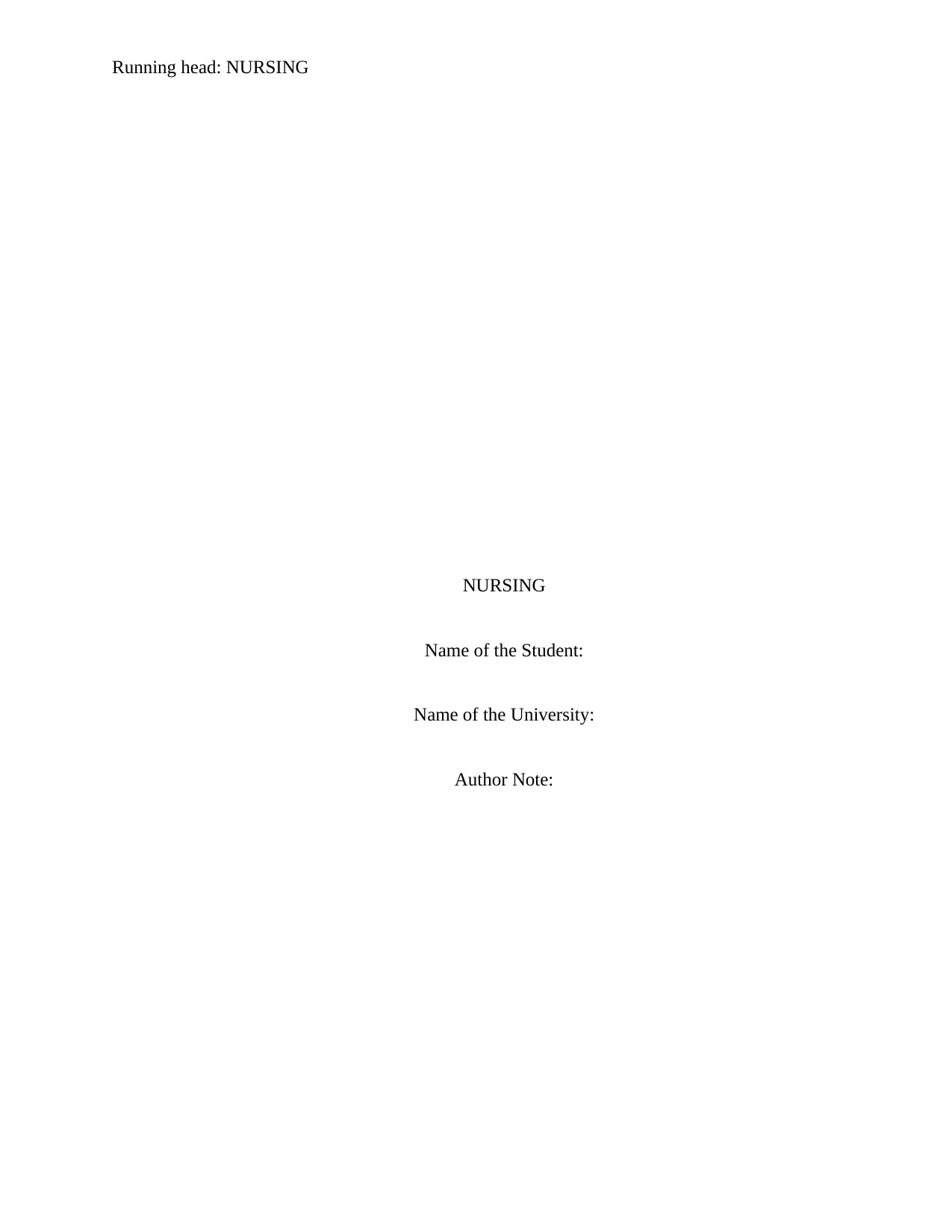
Running head: NURSING
NURSING
Name of the Student:
Name of the University:
Author Note:
NURSING
Name of the Student:
Name of the University:
Author Note:
Paraphrase This Document
Need a fresh take? Get an instant paraphrase of this document with our AI Paraphraser
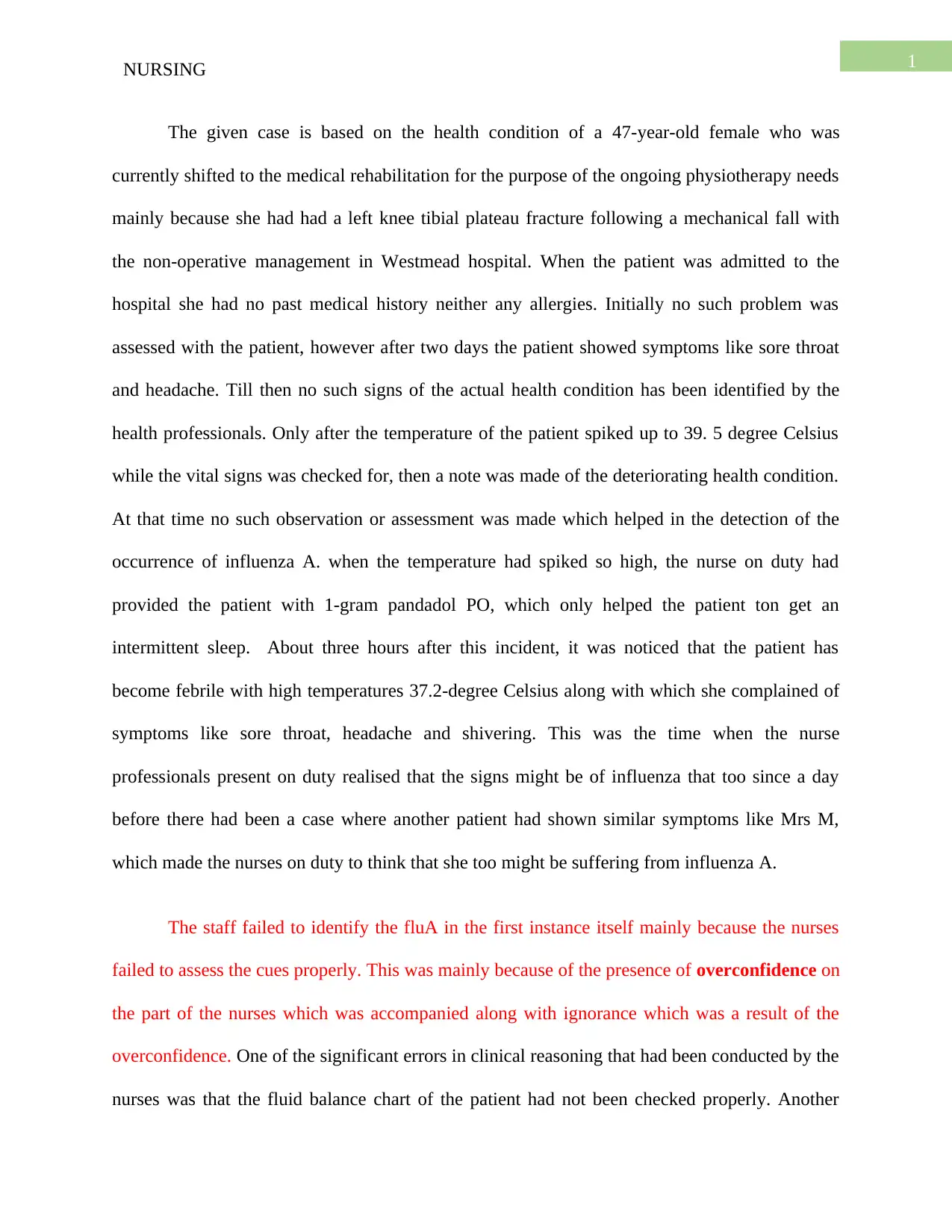
1NURSING
The given case is based on the health condition of a 47-year-old female who was
currently shifted to the medical rehabilitation for the purpose of the ongoing physiotherapy needs
mainly because she had had a left knee tibial plateau fracture following a mechanical fall with
the non-operative management in Westmead hospital. When the patient was admitted to the
hospital she had no past medical history neither any allergies. Initially no such problem was
assessed with the patient, however after two days the patient showed symptoms like sore throat
and headache. Till then no such signs of the actual health condition has been identified by the
health professionals. Only after the temperature of the patient spiked up to 39. 5 degree Celsius
while the vital signs was checked for, then a note was made of the deteriorating health condition.
At that time no such observation or assessment was made which helped in the detection of the
occurrence of influenza A. when the temperature had spiked so high, the nurse on duty had
provided the patient with 1-gram pandadol PO, which only helped the patient ton get an
intermittent sleep. About three hours after this incident, it was noticed that the patient has
become febrile with high temperatures 37.2-degree Celsius along with which she complained of
symptoms like sore throat, headache and shivering. This was the time when the nurse
professionals present on duty realised that the signs might be of influenza that too since a day
before there had been a case where another patient had shown similar symptoms like Mrs M,
which made the nurses on duty to think that she too might be suffering from influenza A.
The staff failed to identify the fluA in the first instance itself mainly because the nurses
failed to assess the cues properly. This was mainly because of the presence of overconfidence on
the part of the nurses which was accompanied along with ignorance which was a result of the
overconfidence. One of the significant errors in clinical reasoning that had been conducted by the
nurses was that the fluid balance chart of the patient had not been checked properly. Another
The given case is based on the health condition of a 47-year-old female who was
currently shifted to the medical rehabilitation for the purpose of the ongoing physiotherapy needs
mainly because she had had a left knee tibial plateau fracture following a mechanical fall with
the non-operative management in Westmead hospital. When the patient was admitted to the
hospital she had no past medical history neither any allergies. Initially no such problem was
assessed with the patient, however after two days the patient showed symptoms like sore throat
and headache. Till then no such signs of the actual health condition has been identified by the
health professionals. Only after the temperature of the patient spiked up to 39. 5 degree Celsius
while the vital signs was checked for, then a note was made of the deteriorating health condition.
At that time no such observation or assessment was made which helped in the detection of the
occurrence of influenza A. when the temperature had spiked so high, the nurse on duty had
provided the patient with 1-gram pandadol PO, which only helped the patient ton get an
intermittent sleep. About three hours after this incident, it was noticed that the patient has
become febrile with high temperatures 37.2-degree Celsius along with which she complained of
symptoms like sore throat, headache and shivering. This was the time when the nurse
professionals present on duty realised that the signs might be of influenza that too since a day
before there had been a case where another patient had shown similar symptoms like Mrs M,
which made the nurses on duty to think that she too might be suffering from influenza A.
The staff failed to identify the fluA in the first instance itself mainly because the nurses
failed to assess the cues properly. This was mainly because of the presence of overconfidence on
the part of the nurses which was accompanied along with ignorance which was a result of the
overconfidence. One of the significant errors in clinical reasoning that had been conducted by the
nurses was that the fluid balance chart of the patient had not been checked properly. Another
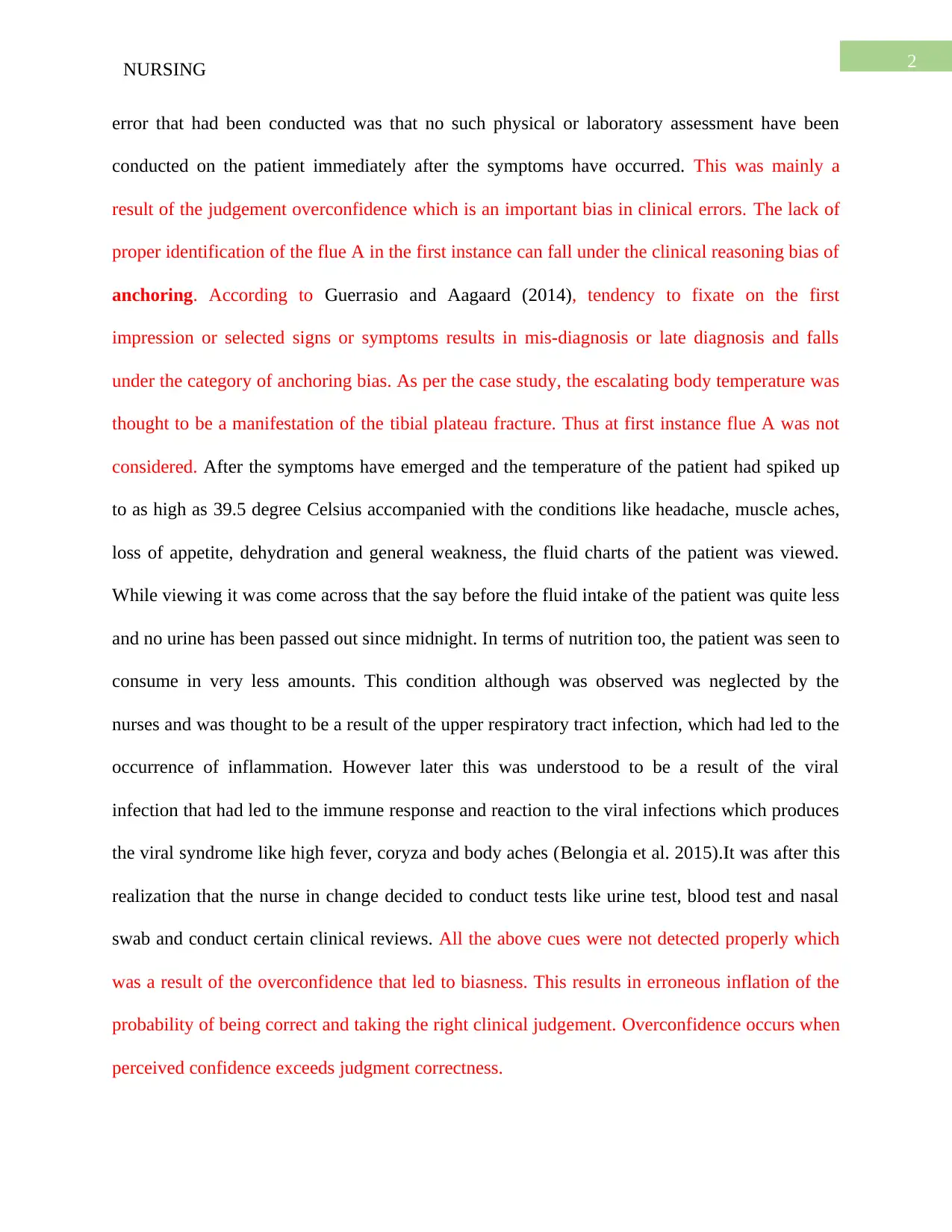
2NURSING
error that had been conducted was that no such physical or laboratory assessment have been
conducted on the patient immediately after the symptoms have occurred. This was mainly a
result of the judgement overconfidence which is an important bias in clinical errors. The lack of
proper identification of the flue A in the first instance can fall under the clinical reasoning bias of
anchoring. According to Guerrasio and Aagaard (2014), tendency to fixate on the first
impression or selected signs or symptoms results in mis-diagnosis or late diagnosis and falls
under the category of anchoring bias. As per the case study, the escalating body temperature was
thought to be a manifestation of the tibial plateau fracture. Thus at first instance flue A was not
considered. After the symptoms have emerged and the temperature of the patient had spiked up
to as high as 39.5 degree Celsius accompanied with the conditions like headache, muscle aches,
loss of appetite, dehydration and general weakness, the fluid charts of the patient was viewed.
While viewing it was come across that the say before the fluid intake of the patient was quite less
and no urine has been passed out since midnight. In terms of nutrition too, the patient was seen to
consume in very less amounts. This condition although was observed was neglected by the
nurses and was thought to be a result of the upper respiratory tract infection, which had led to the
occurrence of inflammation. However later this was understood to be a result of the viral
infection that had led to the immune response and reaction to the viral infections which produces
the viral syndrome like high fever, coryza and body aches (Belongia et al. 2015).It was after this
realization that the nurse in change decided to conduct tests like urine test, blood test and nasal
swab and conduct certain clinical reviews. All the above cues were not detected properly which
was a result of the overconfidence that led to biasness. This results in erroneous inflation of the
probability of being correct and taking the right clinical judgement. Overconfidence occurs when
perceived confidence exceeds judgment correctness.
error that had been conducted was that no such physical or laboratory assessment have been
conducted on the patient immediately after the symptoms have occurred. This was mainly a
result of the judgement overconfidence which is an important bias in clinical errors. The lack of
proper identification of the flue A in the first instance can fall under the clinical reasoning bias of
anchoring. According to Guerrasio and Aagaard (2014), tendency to fixate on the first
impression or selected signs or symptoms results in mis-diagnosis or late diagnosis and falls
under the category of anchoring bias. As per the case study, the escalating body temperature was
thought to be a manifestation of the tibial plateau fracture. Thus at first instance flue A was not
considered. After the symptoms have emerged and the temperature of the patient had spiked up
to as high as 39.5 degree Celsius accompanied with the conditions like headache, muscle aches,
loss of appetite, dehydration and general weakness, the fluid charts of the patient was viewed.
While viewing it was come across that the say before the fluid intake of the patient was quite less
and no urine has been passed out since midnight. In terms of nutrition too, the patient was seen to
consume in very less amounts. This condition although was observed was neglected by the
nurses and was thought to be a result of the upper respiratory tract infection, which had led to the
occurrence of inflammation. However later this was understood to be a result of the viral
infection that had led to the immune response and reaction to the viral infections which produces
the viral syndrome like high fever, coryza and body aches (Belongia et al. 2015).It was after this
realization that the nurse in change decided to conduct tests like urine test, blood test and nasal
swab and conduct certain clinical reviews. All the above cues were not detected properly which
was a result of the overconfidence that led to biasness. This results in erroneous inflation of the
probability of being correct and taking the right clinical judgement. Overconfidence occurs when
perceived confidence exceeds judgment correctness.
⊘ This is a preview!⊘
Do you want full access?
Subscribe today to unlock all pages.

Trusted by 1+ million students worldwide
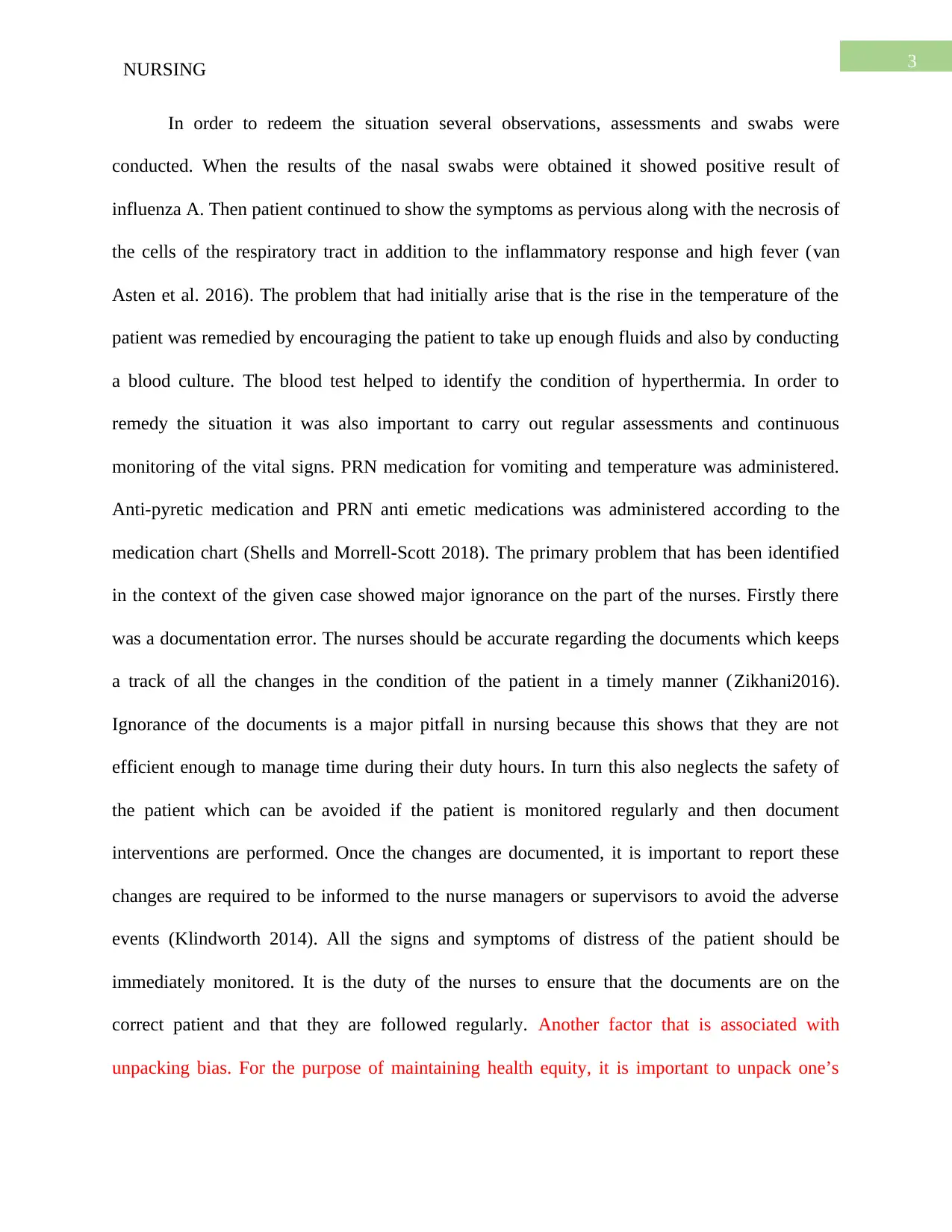
3NURSING
In order to redeem the situation several observations, assessments and swabs were
conducted. When the results of the nasal swabs were obtained it showed positive result of
influenza A. Then patient continued to show the symptoms as pervious along with the necrosis of
the cells of the respiratory tract in addition to the inflammatory response and high fever (van
Asten et al. 2016). The problem that had initially arise that is the rise in the temperature of the
patient was remedied by encouraging the patient to take up enough fluids and also by conducting
a blood culture. The blood test helped to identify the condition of hyperthermia. In order to
remedy the situation it was also important to carry out regular assessments and continuous
monitoring of the vital signs. PRN medication for vomiting and temperature was administered.
Anti-pyretic medication and PRN anti emetic medications was administered according to the
medication chart (Shells and Morrell-Scott 2018). The primary problem that has been identified
in the context of the given case showed major ignorance on the part of the nurses. Firstly there
was a documentation error. The nurses should be accurate regarding the documents which keeps
a track of all the changes in the condition of the patient in a timely manner (Zikhani2016).
Ignorance of the documents is a major pitfall in nursing because this shows that they are not
efficient enough to manage time during their duty hours. In turn this also neglects the safety of
the patient which can be avoided if the patient is monitored regularly and then document
interventions are performed. Once the changes are documented, it is important to report these
changes are required to be informed to the nurse managers or supervisors to avoid the adverse
events (Klindworth 2014). All the signs and symptoms of distress of the patient should be
immediately monitored. It is the duty of the nurses to ensure that the documents are on the
correct patient and that they are followed regularly. Another factor that is associated with
unpacking bias. For the purpose of maintaining health equity, it is important to unpack one’s
In order to redeem the situation several observations, assessments and swabs were
conducted. When the results of the nasal swabs were obtained it showed positive result of
influenza A. Then patient continued to show the symptoms as pervious along with the necrosis of
the cells of the respiratory tract in addition to the inflammatory response and high fever (van
Asten et al. 2016). The problem that had initially arise that is the rise in the temperature of the
patient was remedied by encouraging the patient to take up enough fluids and also by conducting
a blood culture. The blood test helped to identify the condition of hyperthermia. In order to
remedy the situation it was also important to carry out regular assessments and continuous
monitoring of the vital signs. PRN medication for vomiting and temperature was administered.
Anti-pyretic medication and PRN anti emetic medications was administered according to the
medication chart (Shells and Morrell-Scott 2018). The primary problem that has been identified
in the context of the given case showed major ignorance on the part of the nurses. Firstly there
was a documentation error. The nurses should be accurate regarding the documents which keeps
a track of all the changes in the condition of the patient in a timely manner (Zikhani2016).
Ignorance of the documents is a major pitfall in nursing because this shows that they are not
efficient enough to manage time during their duty hours. In turn this also neglects the safety of
the patient which can be avoided if the patient is monitored regularly and then document
interventions are performed. Once the changes are documented, it is important to report these
changes are required to be informed to the nurse managers or supervisors to avoid the adverse
events (Klindworth 2014). All the signs and symptoms of distress of the patient should be
immediately monitored. It is the duty of the nurses to ensure that the documents are on the
correct patient and that they are followed regularly. Another factor that is associated with
unpacking bias. For the purpose of maintaining health equity, it is important to unpack one’s
Paraphrase This Document
Need a fresh take? Get an instant paraphrase of this document with our AI Paraphraser
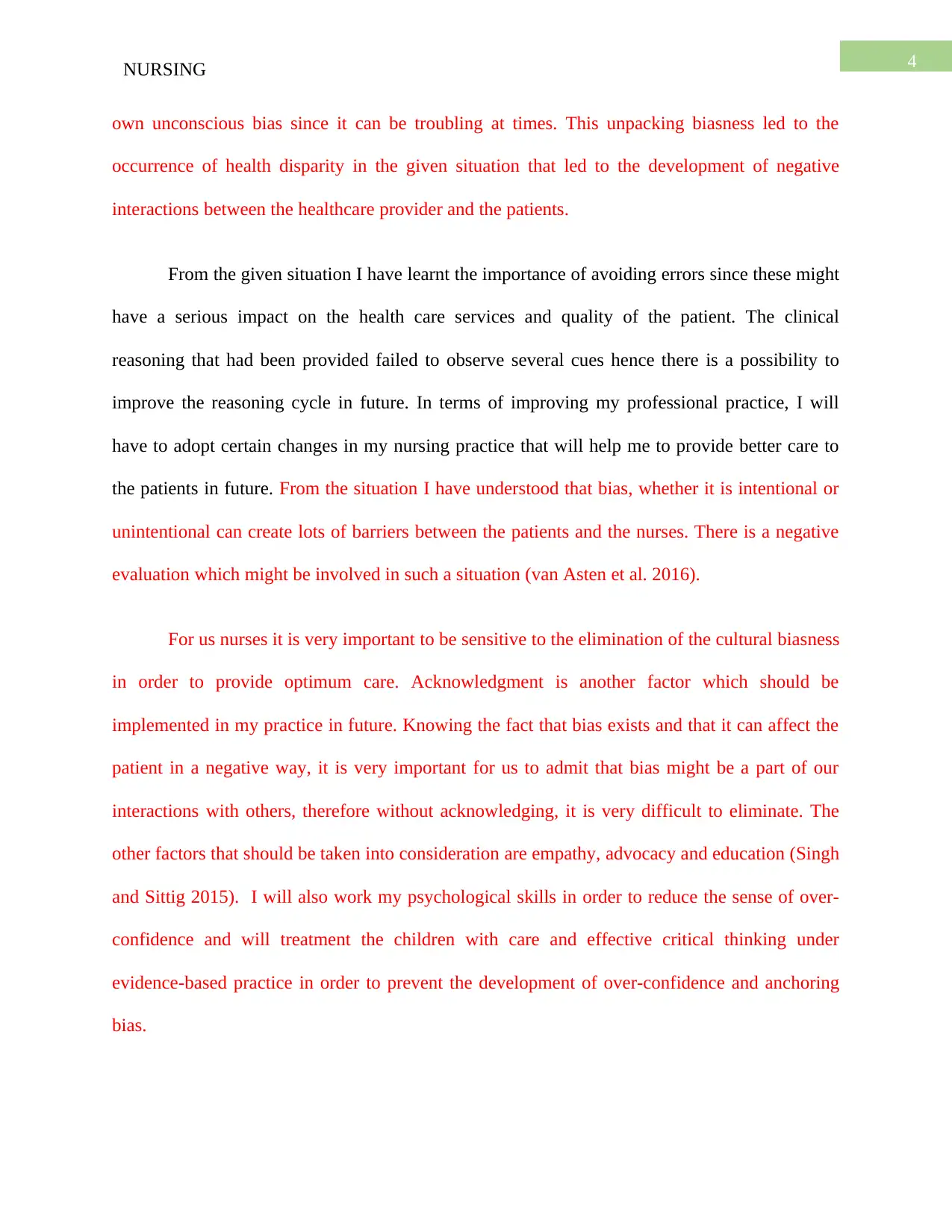
4NURSING
own unconscious bias since it can be troubling at times. This unpacking biasness led to the
occurrence of health disparity in the given situation that led to the development of negative
interactions between the healthcare provider and the patients.
From the given situation I have learnt the importance of avoiding errors since these might
have a serious impact on the health care services and quality of the patient. The clinical
reasoning that had been provided failed to observe several cues hence there is a possibility to
improve the reasoning cycle in future. In terms of improving my professional practice, I will
have to adopt certain changes in my nursing practice that will help me to provide better care to
the patients in future. From the situation I have understood that bias, whether it is intentional or
unintentional can create lots of barriers between the patients and the nurses. There is a negative
evaluation which might be involved in such a situation (van Asten et al. 2016).
For us nurses it is very important to be sensitive to the elimination of the cultural biasness
in order to provide optimum care. Acknowledgment is another factor which should be
implemented in my practice in future. Knowing the fact that bias exists and that it can affect the
patient in a negative way, it is very important for us to admit that bias might be a part of our
interactions with others, therefore without acknowledging, it is very difficult to eliminate. The
other factors that should be taken into consideration are empathy, advocacy and education (Singh
and Sittig 2015). I will also work my psychological skills in order to reduce the sense of over-
confidence and will treatment the children with care and effective critical thinking under
evidence-based practice in order to prevent the development of over-confidence and anchoring
bias.
own unconscious bias since it can be troubling at times. This unpacking biasness led to the
occurrence of health disparity in the given situation that led to the development of negative
interactions between the healthcare provider and the patients.
From the given situation I have learnt the importance of avoiding errors since these might
have a serious impact on the health care services and quality of the patient. The clinical
reasoning that had been provided failed to observe several cues hence there is a possibility to
improve the reasoning cycle in future. In terms of improving my professional practice, I will
have to adopt certain changes in my nursing practice that will help me to provide better care to
the patients in future. From the situation I have understood that bias, whether it is intentional or
unintentional can create lots of barriers between the patients and the nurses. There is a negative
evaluation which might be involved in such a situation (van Asten et al. 2016).
For us nurses it is very important to be sensitive to the elimination of the cultural biasness
in order to provide optimum care. Acknowledgment is another factor which should be
implemented in my practice in future. Knowing the fact that bias exists and that it can affect the
patient in a negative way, it is very important for us to admit that bias might be a part of our
interactions with others, therefore without acknowledging, it is very difficult to eliminate. The
other factors that should be taken into consideration are empathy, advocacy and education (Singh
and Sittig 2015). I will also work my psychological skills in order to reduce the sense of over-
confidence and will treatment the children with care and effective critical thinking under
evidence-based practice in order to prevent the development of over-confidence and anchoring
bias.
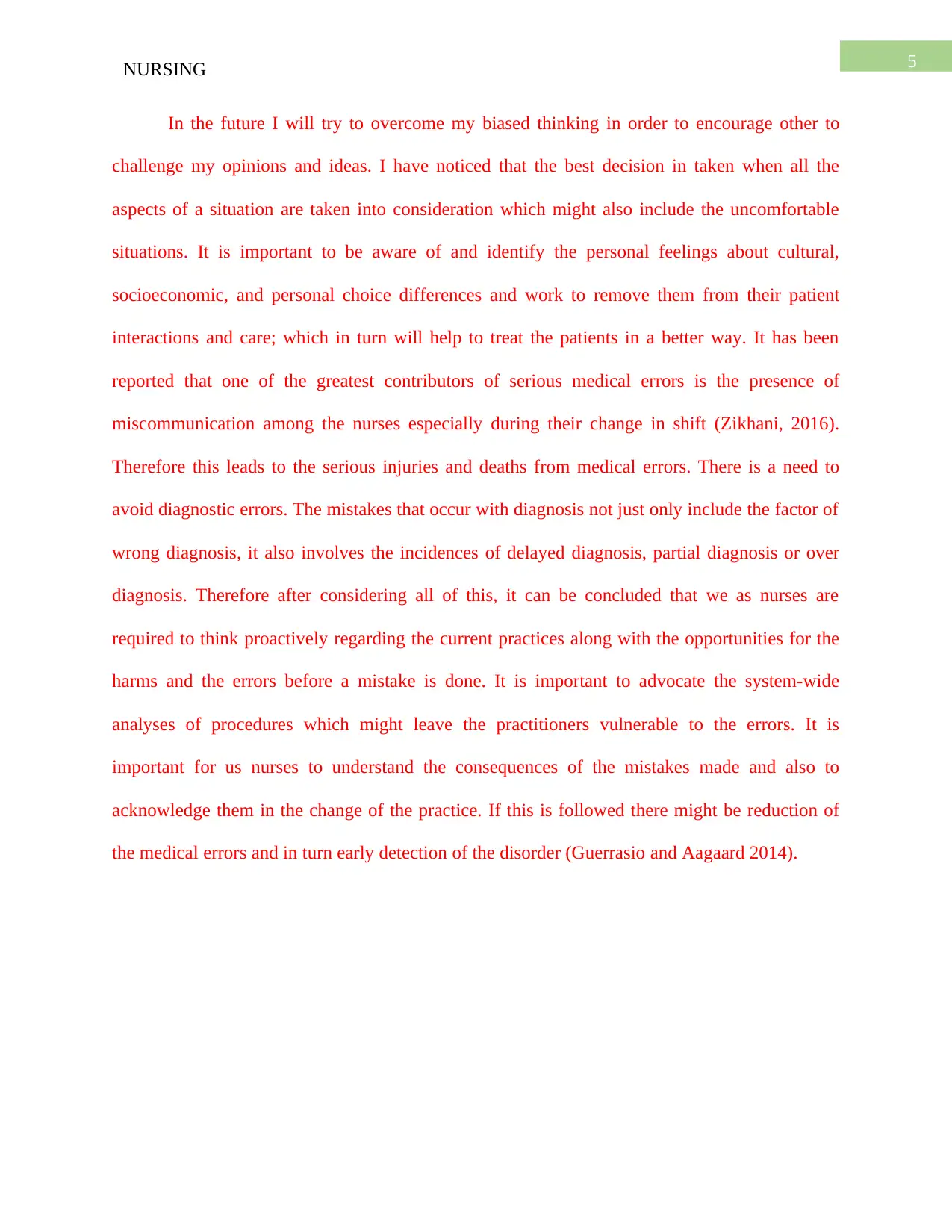
5NURSING
In the future I will try to overcome my biased thinking in order to encourage other to
challenge my opinions and ideas. I have noticed that the best decision in taken when all the
aspects of a situation are taken into consideration which might also include the uncomfortable
situations. It is important to be aware of and identify the personal feelings about cultural,
socioeconomic, and personal choice differences and work to remove them from their patient
interactions and care; which in turn will help to treat the patients in a better way. It has been
reported that one of the greatest contributors of serious medical errors is the presence of
miscommunication among the nurses especially during their change in shift (Zikhani, 2016).
Therefore this leads to the serious injuries and deaths from medical errors. There is a need to
avoid diagnostic errors. The mistakes that occur with diagnosis not just only include the factor of
wrong diagnosis, it also involves the incidences of delayed diagnosis, partial diagnosis or over
diagnosis. Therefore after considering all of this, it can be concluded that we as nurses are
required to think proactively regarding the current practices along with the opportunities for the
harms and the errors before a mistake is done. It is important to advocate the system-wide
analyses of procedures which might leave the practitioners vulnerable to the errors. It is
important for us nurses to understand the consequences of the mistakes made and also to
acknowledge them in the change of the practice. If this is followed there might be reduction of
the medical errors and in turn early detection of the disorder (Guerrasio and Aagaard 2014).
In the future I will try to overcome my biased thinking in order to encourage other to
challenge my opinions and ideas. I have noticed that the best decision in taken when all the
aspects of a situation are taken into consideration which might also include the uncomfortable
situations. It is important to be aware of and identify the personal feelings about cultural,
socioeconomic, and personal choice differences and work to remove them from their patient
interactions and care; which in turn will help to treat the patients in a better way. It has been
reported that one of the greatest contributors of serious medical errors is the presence of
miscommunication among the nurses especially during their change in shift (Zikhani, 2016).
Therefore this leads to the serious injuries and deaths from medical errors. There is a need to
avoid diagnostic errors. The mistakes that occur with diagnosis not just only include the factor of
wrong diagnosis, it also involves the incidences of delayed diagnosis, partial diagnosis or over
diagnosis. Therefore after considering all of this, it can be concluded that we as nurses are
required to think proactively regarding the current practices along with the opportunities for the
harms and the errors before a mistake is done. It is important to advocate the system-wide
analyses of procedures which might leave the practitioners vulnerable to the errors. It is
important for us nurses to understand the consequences of the mistakes made and also to
acknowledge them in the change of the practice. If this is followed there might be reduction of
the medical errors and in turn early detection of the disorder (Guerrasio and Aagaard 2014).
⊘ This is a preview!⊘
Do you want full access?
Subscribe today to unlock all pages.

Trusted by 1+ million students worldwide
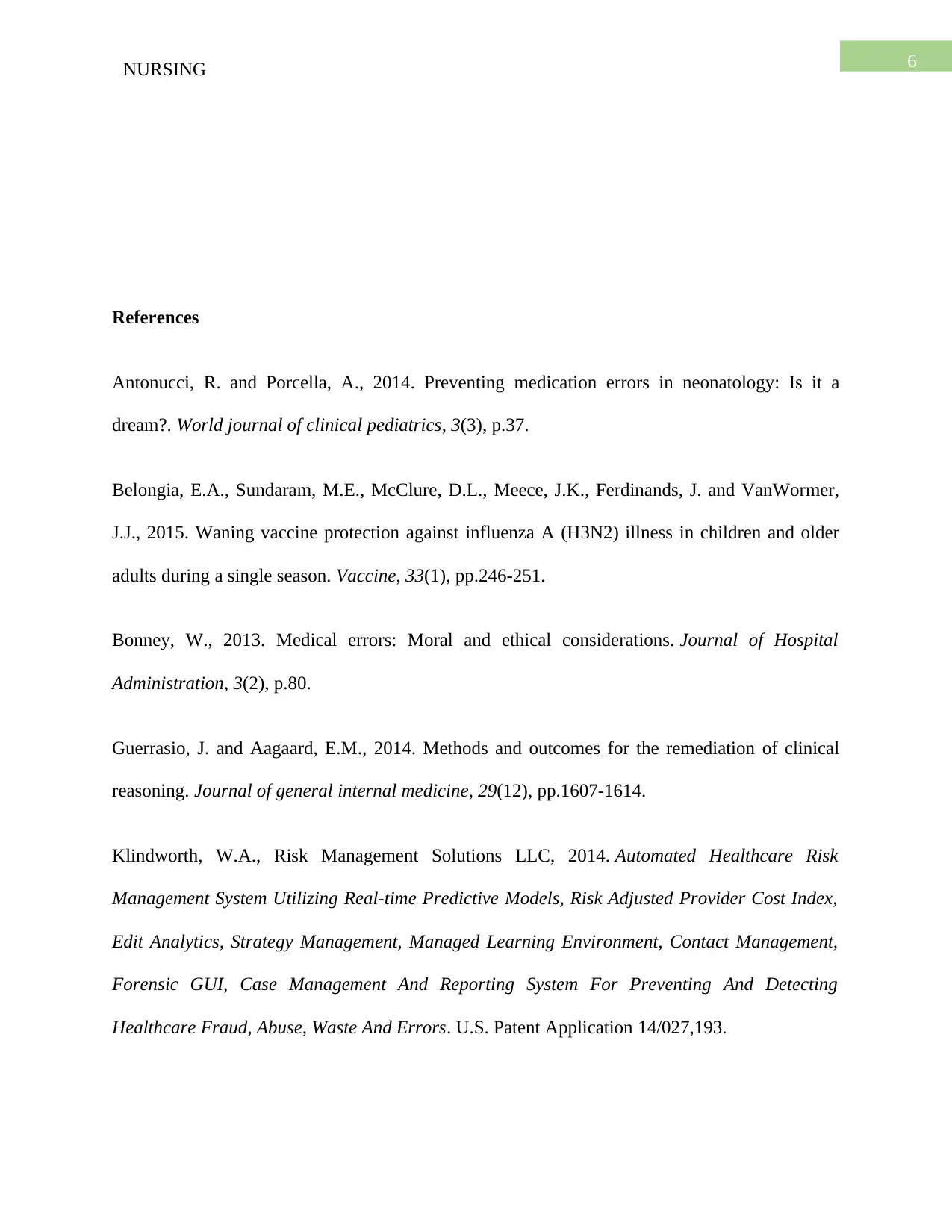
6NURSING
References
Antonucci, R. and Porcella, A., 2014. Preventing medication errors in neonatology: Is it a
dream?. World journal of clinical pediatrics, 3(3), p.37.
Belongia, E.A., Sundaram, M.E., McClure, D.L., Meece, J.K., Ferdinands, J. and VanWormer,
J.J., 2015. Waning vaccine protection against influenza A (H3N2) illness in children and older
adults during a single season. Vaccine, 33(1), pp.246-251.
Bonney, W., 2013. Medical errors: Moral and ethical considerations. Journal of Hospital
Administration, 3(2), p.80.
Guerrasio, J. and Aagaard, E.M., 2014. Methods and outcomes for the remediation of clinical
reasoning. Journal of general internal medicine, 29(12), pp.1607-1614.
Klindworth, W.A., Risk Management Solutions LLC, 2014. Automated Healthcare Risk
Management System Utilizing Real-time Predictive Models, Risk Adjusted Provider Cost Index,
Edit Analytics, Strategy Management, Managed Learning Environment, Contact Management,
Forensic GUI, Case Management And Reporting System For Preventing And Detecting
Healthcare Fraud, Abuse, Waste And Errors. U.S. Patent Application 14/027,193.
References
Antonucci, R. and Porcella, A., 2014. Preventing medication errors in neonatology: Is it a
dream?. World journal of clinical pediatrics, 3(3), p.37.
Belongia, E.A., Sundaram, M.E., McClure, D.L., Meece, J.K., Ferdinands, J. and VanWormer,
J.J., 2015. Waning vaccine protection against influenza A (H3N2) illness in children and older
adults during a single season. Vaccine, 33(1), pp.246-251.
Bonney, W., 2013. Medical errors: Moral and ethical considerations. Journal of Hospital
Administration, 3(2), p.80.
Guerrasio, J. and Aagaard, E.M., 2014. Methods and outcomes for the remediation of clinical
reasoning. Journal of general internal medicine, 29(12), pp.1607-1614.
Klindworth, W.A., Risk Management Solutions LLC, 2014. Automated Healthcare Risk
Management System Utilizing Real-time Predictive Models, Risk Adjusted Provider Cost Index,
Edit Analytics, Strategy Management, Managed Learning Environment, Contact Management,
Forensic GUI, Case Management And Reporting System For Preventing And Detecting
Healthcare Fraud, Abuse, Waste And Errors. U.S. Patent Application 14/027,193.
Paraphrase This Document
Need a fresh take? Get an instant paraphrase of this document with our AI Paraphraser
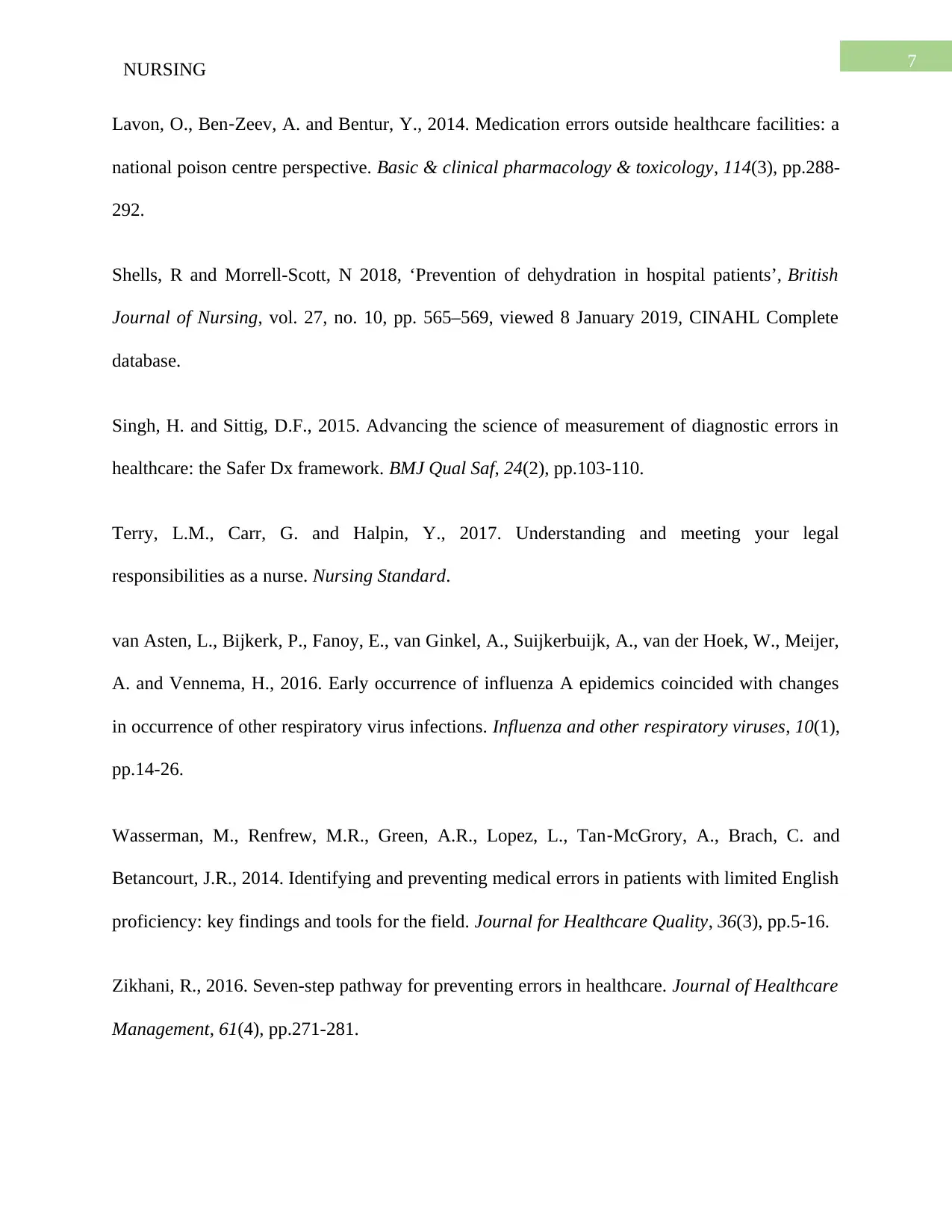
7NURSING
Lavon, O., Ben‐Zeev, A. and Bentur, Y., 2014. Medication errors outside healthcare facilities: a
national poison centre perspective. Basic & clinical pharmacology & toxicology, 114(3), pp.288-
292.
Shells, R and Morrell-Scott, N 2018, ‘Prevention of dehydration in hospital patients’, British
Journal of Nursing, vol. 27, no. 10, pp. 565–569, viewed 8 January 2019, CINAHL Complete
database.
Singh, H. and Sittig, D.F., 2015. Advancing the science of measurement of diagnostic errors in
healthcare: the Safer Dx framework. BMJ Qual Saf, 24(2), pp.103-110.
Terry, L.M., Carr, G. and Halpin, Y., 2017. Understanding and meeting your legal
responsibilities as a nurse. Nursing Standard.
van Asten, L., Bijkerk, P., Fanoy, E., van Ginkel, A., Suijkerbuijk, A., van der Hoek, W., Meijer,
A. and Vennema, H., 2016. Early occurrence of influenza A epidemics coincided with changes
in occurrence of other respiratory virus infections. Influenza and other respiratory viruses, 10(1),
pp.14-26.
Wasserman, M., Renfrew, M.R., Green, A.R., Lopez, L., Tan‐McGrory, A., Brach, C. and
Betancourt, J.R., 2014. Identifying and preventing medical errors in patients with limited English
proficiency: key findings and tools for the field. Journal for Healthcare Quality, 36(3), pp.5-16.
Zikhani, R., 2016. Seven-step pathway for preventing errors in healthcare. Journal of Healthcare
Management, 61(4), pp.271-281.
Lavon, O., Ben‐Zeev, A. and Bentur, Y., 2014. Medication errors outside healthcare facilities: a
national poison centre perspective. Basic & clinical pharmacology & toxicology, 114(3), pp.288-
292.
Shells, R and Morrell-Scott, N 2018, ‘Prevention of dehydration in hospital patients’, British
Journal of Nursing, vol. 27, no. 10, pp. 565–569, viewed 8 January 2019, CINAHL Complete
database.
Singh, H. and Sittig, D.F., 2015. Advancing the science of measurement of diagnostic errors in
healthcare: the Safer Dx framework. BMJ Qual Saf, 24(2), pp.103-110.
Terry, L.M., Carr, G. and Halpin, Y., 2017. Understanding and meeting your legal
responsibilities as a nurse. Nursing Standard.
van Asten, L., Bijkerk, P., Fanoy, E., van Ginkel, A., Suijkerbuijk, A., van der Hoek, W., Meijer,
A. and Vennema, H., 2016. Early occurrence of influenza A epidemics coincided with changes
in occurrence of other respiratory virus infections. Influenza and other respiratory viruses, 10(1),
pp.14-26.
Wasserman, M., Renfrew, M.R., Green, A.R., Lopez, L., Tan‐McGrory, A., Brach, C. and
Betancourt, J.R., 2014. Identifying and preventing medical errors in patients with limited English
proficiency: key findings and tools for the field. Journal for Healthcare Quality, 36(3), pp.5-16.
Zikhani, R., 2016. Seven-step pathway for preventing errors in healthcare. Journal of Healthcare
Management, 61(4), pp.271-281.
1 out of 8
Your All-in-One AI-Powered Toolkit for Academic Success.
+13062052269
info@desklib.com
Available 24*7 on WhatsApp / Email
![[object Object]](/_next/static/media/star-bottom.7253800d.svg)
Unlock your academic potential
Copyright © 2020–2025 A2Z Services. All Rights Reserved. Developed and managed by ZUCOL.

